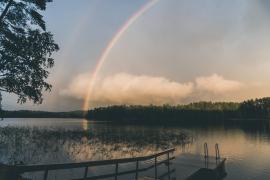One of my fondest camp memories is of sitting in a large platform tent with my other new friends during a torrential downpour.
Like most suburban kids I knew, I had long been schooled to come in the house when it rained, and this "sorta house" was certainly not what my mother had in mind. I can smell wet canvas, damp forest, and mud right now. Like walking with a flashlight a hundred yards in the dark to get to the latrine, this was also part of the adventure that brought me back to camp year after year. Somehow, even in the 1970s (Wow! That long ago already?), caregivers had a plan and knew when to gather their charges from the tents and relocate to the cinder block building before things got too dicey. As an adult, I’ve come to appreciate the planning and preparation that made the experience exciting without being excessively dangerous. I’ve also come to recognize the very real weather threats to facilities that support outdoor recreation and experiences. Once guest safety has been addressed, the very next steps should protect the capital investments from whatever Mother Nature is likely to deliver. This time we’re going to look at some things to help prepare for the next bit of weather excitement.
T-E-A-M!
Developing plans to deal with weather-related damage to camp is not for any one individual or position. As the facilities support the programs and guest services assembles an emergency action plan, the specific steps to bring everything back on line must be closely tied together. Support staff like kitchen, housekeeping, and grounds are all best able to recognize and forecast how their piece of camp will be affected in every "what if" scenario. The financial manager is best able to project how short- or long-term facility losses might affect revenue, as well as cash sources to cover expenses while insurance claims are processed. And of course, camp’s insurance broker is a pivotal player in this drama. The point here is that a successful, functional plan will require everyone’s involvement. Everyone’s focused time and effort will save thousands of dollars in the end.
"That’s What Insurance Is For!"
We’ve all heard that expression at one time or another, but as savvy business owners and operators, we also should be familiar with the legal phrase "covered peril." Your policy is full of "this but not that" lists, and, like an egg hunt in the spring, sometimes those things are so well placed that you need to know where to look to find them. Consider this a prime opportunity to schedule a couple of hour-long chats with your broker. Explain that you’re trying to develop a plan to respond to weather damage and claims and that you want to better understand what your coverage provides. Maybe even more important is what it does not provide, because these are the kinds of surprises that typically compound the grief of cleaning up after a big event. I’ve found that these conversations are best had with both of you holding the same copy of the policy and having the expert walk you through the whole thing from top to bottom. You may well have forgotten things you once knew, or perhaps changes have been made to how certain points are read or interpreted since you last reviewed your policy.
In meetings with your broker, be sure to ask about all sorts of property improvements besides just the buildings. Those include:
- Infrastructure (both buried and above ground) like propane tanks and service lines, water and sewage systems. If you have a wastewater treatment system that depends on electrical power, is camp covered for spills, temporary facilities while repairs are being made, or loss of income in case you have to send campers home and issue refunds?
- Program areas such as waterfront and challenge courses. If your program depends on waterfront activities and your boat dock or swimming area has to be repaired, will insurance help cover the costs of permits and the special construction efforts necessary to work in riparian or estuarian environments?
- Accesses, roads, and trails. Safety plans often assume that emergency services can access program areas, especially those where injuries are more likely. If vehicle access is blocked by down trees after a microburst, will insurance help with the cost for professionals to clear that quickly and safely to return the program area to use?
This discussion will build a detailed understanding of how and when your insurance would respond to damage.
Note that a "standard of care" is often associated with paying claims. That is, unless there is "full replacement value" coverage on the claim, the adjuster will evaluate the condition of the facility before the damage occurred. If your maintenance shop was a tumble-down shack with a leaky roof and crummy wiring, you shouldn’t expect to be wholly compensated for a shiny new one after a dead tree smashes through it. Expect depreciation to reduce claims and make sure that your cash reserves are structured to pick up that difference when rebuilding. Some facilities on the property may have depreciated to a point where insuring them just doesn’t make sense anymore, so stop paying a premium for those!
"Hey, Noah, How Long Can You Tread Water?"
Longtime occupants of any property have a well-earned sixth sense when it comes to flash floods and overflowing stream banks. But as once-remote camp properties are more and more surrounded by development, those over-the-banks events are happening more often because there is less space for runoff to soak in. It pays for camp leadership to be attuned to changes in land use and developments up hill from camp and to be aware that more water may be coming through that quiet little brook. Unlike water damage from things like broken pipes, camp’s insurance policy likely doesn’t cover flooding from surface water bodies. While your broker may be able to offer flood insurance coverage, it is underwritten by the federal government, and the terms, conditions, and coverages are all dictated by the feds rather than the smiling agent you’ve always worked so well with. Count on a lengthy list of requirements and documents you will need to provide to purchase coverage.
You should know a couple things about flood insurance too. First, there is a waiting period before it’s effective, and I believe the delay is 30 days. This is truly one of those purchases that simply cannot be postponed once the financial and risk analyses are complete. If it makes sense, don’t put it off. Gather the documents, get the inspections, and buy it.
Another thing to bear in mind is that certain improvements in flooding harm’s way may not be insurable at all under the flood insurance program. Flood insurance is generally strictly limited to habitable structures. So, if camp’s pasture and barn are in the flood plain, camp’s general liability insurance or a special provision may be the only insurance tools available. Ask your camp’s broker.
Lastly, buildings within the flood plain can be designed, built, or modified to minimize the effects of flood waters. Mechanical systems like air conditioning units can be placed on elevated platforms above the base flood elevation, and crawl spaces/foundations can be set up to allow water through instead of acting like a dam. These steps may be required for camp to insure buildings subject to flooding, or if they can’t be insured for some reason, at least those things may reduce the damage if flooding occurs.
"Flood" Is Not the Same as "Water Damage"
While "flooding" is "water that causes damage," your insurance expert will tell you that these are two very different terms where it comes to coverage and risk management. "Water damage" is from a malfunction in a building system, like a burst pipe or hot water heater. "Flooding" is from outside water impinging on your building. Your agent may tell you there are gray areas like, "The downspout diverter fell off and the water was directed into our basement." Choose your words wisely when you call your agent to report an incident. Otherwise the reply may be "You’re not covered."
The Abominable Snowman Cometh
For many camps, snow is a certainty. The only real question is "How much will we get?" In areas that see significant snowfall every year, camps have a pretty good idea of what to expect. But every couple of years, it seems that a "storm of the century" appears and there’s much deeper or wetter snow dumped than people expect. The buildings whose roof slope is too flat to shed it are the ones at the greatest risk. Typically, those are the most prominent structures on camp like a dining hall, gym, or other open recreational space with extremely expensive equipment and fixtures inside. With 12, 18, or 24 inches of snow on the roof, what’s to be done? The kitchen space, for example, is full of refrigerators, ovens, fryers, and other appliances. Many of these are situated around the perimeter of the room where walls will provide some protection from a collapsing roof. However, when the snow melts, equipment that wasn’t damaged by the roof will likely be damaged by water. So why not cover those expensive appliances with plastic sheeting in the fall when the building is winterized? The roof can still fall in, but the plastic will [help to] keep the water out of critical mechanical components. Proper planning can also prepare the roof to shed the snow load instead of holding on to it. Roof pitch and material should be part of the discussion with the architect when the building is designed or renovated. A steeper, smooth surface roof like metal standing seam could help to protect that building from collapsing.
"Mighty Oaks from Little Acorns Grow"
Trees are integral to creating the camp environment. With all the other tasks necessary to open or close camp, it can be really hard to look up to see whether there are looming threats to the very buildings we’re working so hard to protect. Whether they’re growing through the power lines overhead or hanging over Bunk #6, trees can be both a benefit and a curse for our programs, facilities, and guests. As simple as tree trimming may look, professional arborists should be both trained and insured to safely reduce these risks at camp. Familiar with the tree species in your area and climate, they can examine trees encroaching on your facilities to identify weak branches, damaged trunks, or even whole specimens that threaten camp operations or occupants. They have the skills and experience to help you head off problems before they happen. Done safely, tree work is seldom a do-it-yourself project, and the cost is peanuts compared to the cost of the lost time and medical care for an injured employee (or guest or weekend volunteer). Budget for two visits a year from your local, professional, insured tree service, spring and fall. Over time, the cost will likely drop as the trees around camp become better groomed and the forest is healthier.
Like just about everything else at camp, the "what if" scenarios are best addressed in plans rather than as emergency responses. Staff injury and facility damage are infinitely better avoided than repaired. It takes time, money, and commitment to develop and implement a comprehensive plan, but isn’t that sort of forward thinking what our parents and campers expect? Weather happens every day; plan to stay ahead of it.
Rick Stryker is a professional engineer who is passionate about camps and the opportunities that they provide. He’s always delighted to answer email questions at [email protected].


